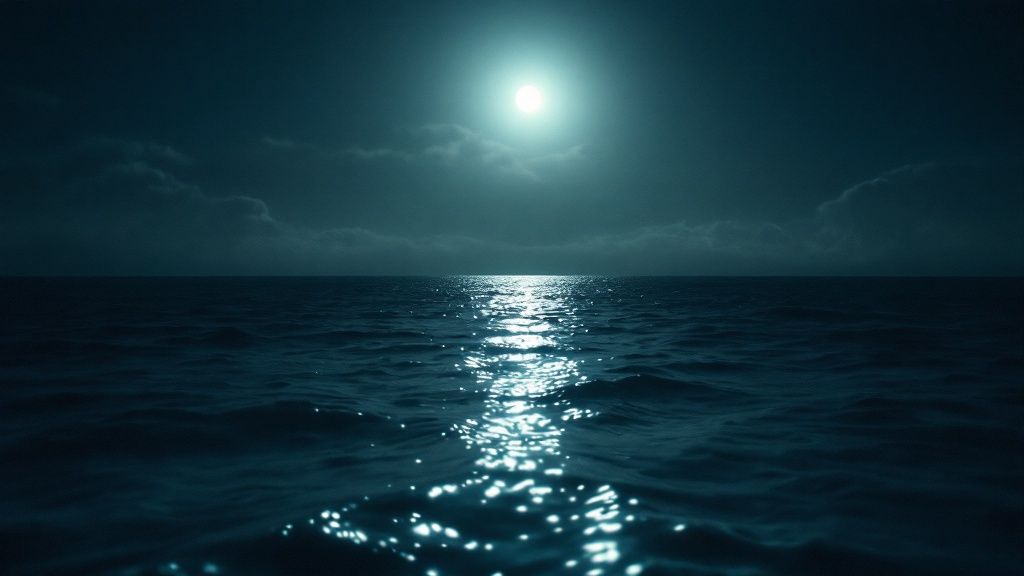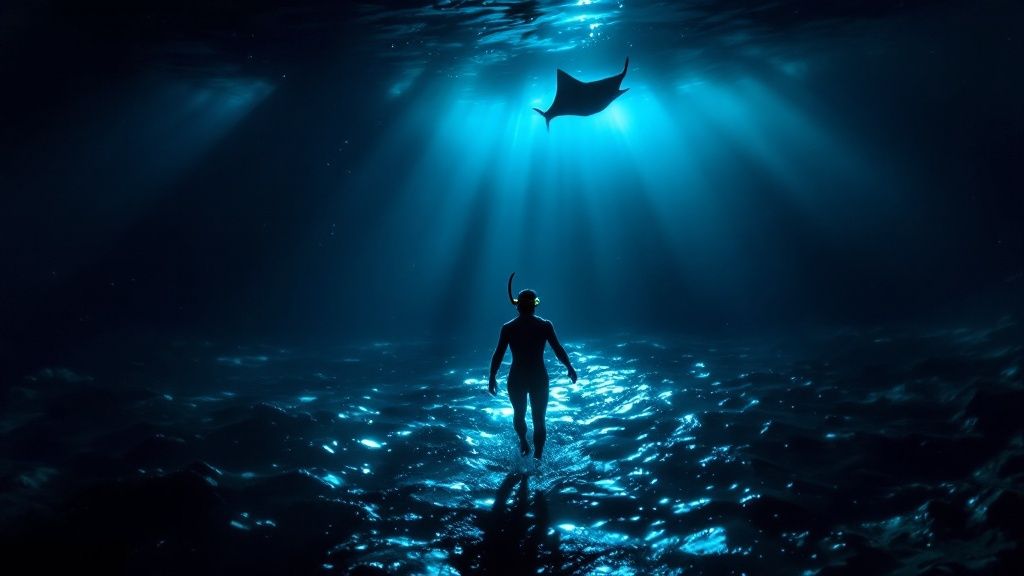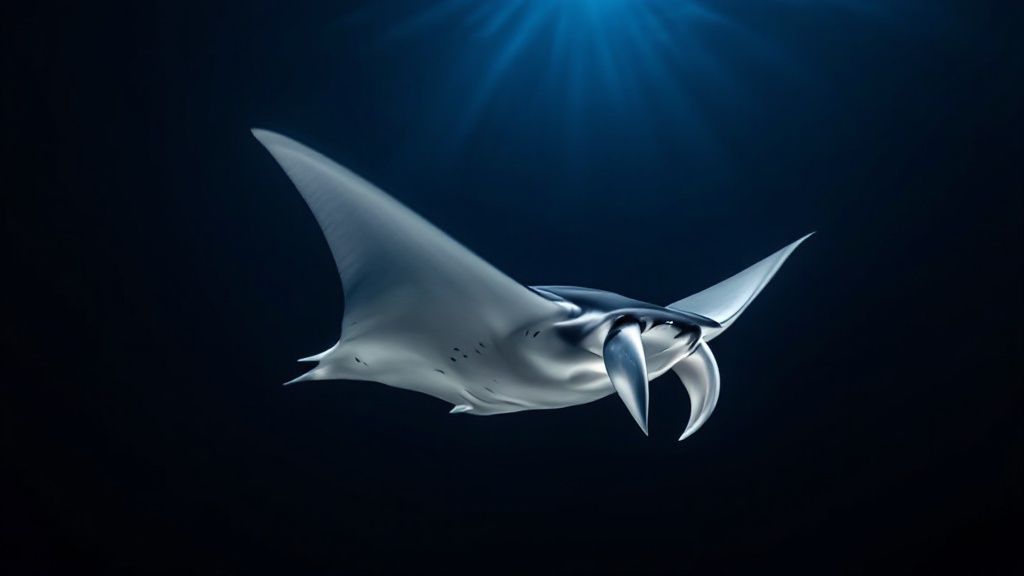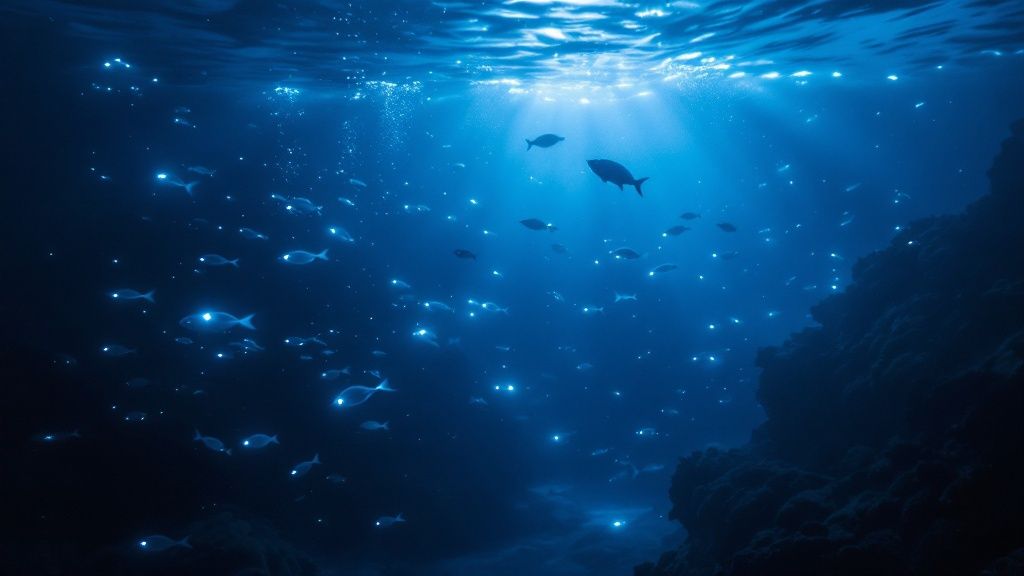Dancing With Giants: The Magic of Night Manta Ray Snorkel Kona

Imagine floating in the dark depths of the Pacific, the only light coming from the gentle glow of underwater lamps. Suddenly, a giant appears: a manta ray, its wings stretching up to 14 feet wide, glides effortlessly through the water. This is the magic of a night manta ray snorkel in Kona, a truly unique experience. Kona, Hawaii, offers a rare chance to see these amazing creatures up close in their natural environment.
This isn’t just a quick peek; Kona offers a very high chance of spotting manta rays. Encounters with these gentle giants are practically guaranteed, making Kona the place for this unforgettable adventure.
How Kona's Environment Attracts Manta Rays
Kona's underwater landscape and rich plankton create a perfect feeding ground, drawing the manta rays to the surface. The specialized underwater lights used during night snorkeling improve visibility and also attract plankton, bringing the mantas even closer to snorkelers.
This leads to remarkably close interactions with these incredible creatures. One of the most appealing parts of this experience is its high success rate. Kona stands out as a top global destination for manta ray encounters with a remarkable 80% to 90% sighting success rate year-round. Approximately 80,000 people snorkel with manta rays in Kona each year. For more detailed statistics, check out Snorkeling with Manta Rays Kona.
Why Choose Kona for Your Night Manta Ray Snorkel?
Many tour operators offer night manta ray snorkeling in Kona, each providing a different kind of experience. Whether you're looking for a small-group tour or a family-friendly outing, you'll find something that suits your needs. Reputable operators prioritize the well-being of the manta rays and follow strict guidelines for sustainable and responsible encounters.
Some top-rated tour operators include Kona Honu Divers, Manta Ray Night Snorkel Hawaii, Kona Snorkel Trips, and Captain Cook Snorkeling Tours. You might also be interested in a Manta Ray Night Dive Kona Hawaii.
This incredible experience is more than just a thrilling adventure. It offers a deep connection with nature and highlights the importance of marine conservation. By choosing a reputable tour operator, you contribute to the research and protection of these majestic creatures while creating memories that will last a lifetime.
The Brilliant Biology Behind Night Manta Ray Encounters

The Kona night manta ray snorkel experience is built upon a captivating relationship between the local environment and the fascinating biology of these creatures. The abundance of plankton, the reef manta rays' (Mobula alfredi) main food source, draws these gentle giants to the Kona coast. This creates an unparalleled opportunity for a truly unique wildlife interaction.
The Light-Plankton Connection
Manta rays are filter feeders. This means they consume tiny organisms by filtering them from the water. Plankton are naturally drawn to light, and gather around specialized lights used by tour operators. This creates a concentrated "plankton buffet," enticing the manta rays closer to the surface. This natural behavior makes it possible to observe these magnificent creatures up close, and also facilitates ongoing manta ray research through close observation and individual identification. For more information, see What is a Manta Ray Night Dive?
This method creates a sustainable and ethical way to interact with manta rays, benefiting both the animals and snorkelers. The night manta ray snorkel in Kona offers a remarkable experience. Underwater lights attract plankton, which in turn, draws manta rays closer to the surface, allowing snorkelers incredible views of their majestic feeding behaviors and dramatic barrel rolls. The exceptionally clear waters of Kona only add to this unforgettable experience. Learn more in this night manta ray snorkel Kona guide.
Understanding Manta Ray Biology
Manta rays are truly impressive animals, with wingspans reaching up to 14 feet. This impressive size is part of their allure, but also makes them more vulnerable to threats such as fishing nets and habitat loss. Their slow reproduction rate, typically giving birth to only one pup every few years, further contributes to their vulnerability.
Identification Research and Local Celebrities
Beyond their size, manta rays possess remarkable intelligence and distinct personalities. Researchers in Kona use the unique spot patterns on the underside of each manta ray to identify individuals. This has led to the rise of local "manta celebrities" whose appearances are eagerly anticipated and tracked year after year by dedicated enthusiasts. Many of these mantas even have names, making a night manta ray snorkel Kona encounter even more special. Several highly-rated tour operators, such as Kona Honu Divers, Manta Ray Night Snorkel Hawaii, Kona Snorkel Trips, and Captain Cook Snorkeling Tours offer valuable information about these incredible animals.
Choosing Your Perfect Night Manta Ray Adventure

Planning a night manta ray snorkel tour in Kona? Not all tours are the same. Selecting the right operator can dramatically improve your experience. Think beyond the price tag. Factors like boat comfort, group size, equipment quality, guide expertise, and the operator's dedication to conservation significantly contribute to a memorable and responsible encounter.
Key Factors to Consider When Booking
When it comes to choosing a night manta ray snorkel tour, several factors deserve your attention. These factors can influence not only your enjoyment of the tour but also the overall impact on the manta rays and their environment.
-
Group Size: Smaller groups often offer a more personalized experience, allowing for better interaction with guides and potentially closer observations of the manta rays. Larger groups can feel more crowded, especially in the water.
-
Boat Comfort: Think about the boat itself. A larger, stable vessel might be preferable if you're prone to seasickness. Smaller, faster boats, however, can sometimes reach the manta ray viewing area more quickly.
-
Guide Expertise: Knowledgeable guides can identify individual manta rays and offer valuable insights into their behavior and biology. They also ensure your safety and comfort in the water, particularly at night.
-
Conservation Commitment: Prioritize operators dedicated to sustainable tourism. Seek out companies that adhere to guidelines for protecting manta rays and their habitat. Look for operators that contribute to research or conservation efforts.
-
Equipment Quality: Make sure the provided snorkel gear – masks, fins, and wetsuits – is in good condition and fits properly. Many operators provide wetsuit rentals for added warmth, essential for comfortable night snorkeling.
To help you compare some of the top options available, we've put together a handy comparison table.
Top Manta Ray Snorkel Tour Operators in Kona
This table compares leading Kona tour companies offering night manta ray snorkeling experiences. It highlights differences in pricing, group sizes, and special features to help you make an informed decision.
| Tour Operator | Price Range | Group Size | Tour Duration | Special Features | Booking Link |
|---|---|---|---|---|---|
| Kona Honu Divers | $100 – $150 | 6-12 | 2-3 hours | Snorkel and dive tours available | Book Now |
| Manta Ray Night Snorkel Hawaii | $120 – $170 | 8-16 | 2.5 hours | Hot beverages and snacks provided | Book Now |
| Kona Snorkel Trips | $95 – $140 | 10-20 | 2 hours | Photography packages available | Book Now |
| Captain Cook Snorkeling Tours | $110 – $160 | 12-24 | 3 hours | Hydrophones for listening to manta ray sounds | Book Now |
As you can see, each operator offers a slightly different package. Consider what's most important to you – group size, tour length, extra amenities – to choose the best fit.
Questions to Ask Potential Operators
Before making a reservation, don't hesitate to contact the tour operators directly. Asking a few key questions can provide valuable information and ensure the experience aligns with your expectations.
- What is your average group size?
- What type of boat do you use?
- How long is the boat ride to the viewing site?
- What are your guides' qualifications and experience?
- What are your safety protocols?
- Do you offer a manta ray guarantee?
Booking Your Adventure
Don't wait to book your Kona night manta ray snorkel tour! Tours can fill up quickly, particularly during peak season. Booking at least two weeks in advance is recommended. Scheduling your snorkel earlier in your trip offers flexibility. Many operators have a “manta ray guarantee," offering a free rebooking if manta rays aren't sighted on your initial tour. This can be a real advantage when encountering wildlife. Check out more information about the experience on Kona Honu Divers.
From Shore to Spectacle: Your Night Manta Ray Snorkel Kona Experience Mapped

So, you've booked your Kona night manta ray snorkel tour. What's next? This guide outlines the entire experience, from arriving at the harbor to returning to shore, to help you prepare for an unforgettable adventure. Knowing what to expect can ease any pre-trip jitters and allow you to fully appreciate the magic of this encounter.
Setting Sail and Pre-Dive Prep
Your manta ray adventure typically begins at the harbor in the late afternoon or early evening. After checking in with your tour operator (like Kona Honu Divers), you'll receive a pre-departure briefing. This briefing covers important safety procedures, how to use the equipment, and guidelines for respectful manta ray interactions.
Once aboard the vessel, the transit time to the viewing location can range from a few minutes up to 45 minutes. During the trip, the crew often shares fascinating facts about manta rays and sets expectations for the snorkel.
Gearing Up and Entering the Water
At the snorkel site, the crew distributes and helps you with snorkeling gear, including masks, fins, and wetsuits if needed. Maintaining a respectful distance from the manta rays is vital for their well-being. Many operators, such as Kona Honu Divers, emphasize sustainable tourism.
They attract plankton, the manta rays' main food source, using specialized lights attached to boards or rafts. You'll enter the water and typically hold onto the float for the best viewing experience. Flotation devices, like pool noodles, are often available for those who prefer extra support. A similar setup is used by other tours, including those offered by Manta Ray Night Snorkel Hawaii and Captain Cook Snorkeling Tours.
The Manta Ballet Begins
As the plankton congregate, the manta rays usually arrive within minutes. These elegant creatures perform an underwater ballet, feeding on the illuminated plankton. The lights create a convenient feast for the mantas, providing snorkelers with an exceptional close-up view. Sometimes, you might even be just inches away!
Guides play a key role in ensuring respectful and safe interactions. They explain manta ray behavior and instruct snorkelers to remain still and refrain from touching the mantas to protect their delicate mucus layer. Kona Snorkel Trips offers additional details about this special encounter. You can also refer to our previous section for advice on selecting a responsible tour operator.
Return to Shore
After about 20-30 minutes in the water, the guides signal the end of the snorkel session. This timeframe allows you to fully enjoy the experience while minimizing disruption to the manta rays. Back on the boat, you'll have a chance to warm up, dry off, and share your incredible experience with fellow snorkelers.
Many operators provide hot beverages and towels for added comfort during the return trip. As the boat heads back to the harbor, the crew often provides a final overview of your unforgettable night manta ray encounter.
Insider Secrets for an Epic Night Manta Ray Encounter
Want to elevate your Kona night manta ray snorkel from memorable to truly amazing? A little preparation and understanding go a long way. These insider tips, gathered from experienced snorkelers and guides, will maximize your comfort, enjoyment, and the chances of a once-in-a-lifetime encounter.
Pre-Trip Preparations for Optimal Comfort
Before you head out on your Kona night manta ray snorkel adventure, preparing for the specific conditions will enhance your overall experience. Think about addressing potential seasickness with medication like Dramamine or motion sickness patches. While Hawaiian waters are typically warm, the night air and water can get cool, especially after the sun sets. Packing layers or a light sweater for the boat ride back is a smart move. Bringing your own well-fitted snorkel gear can also add to your comfort and hygiene.
Mastering the Art of Manta Ray Attraction
Once you’re in the water, understanding how to position yourself will maximize your manta ray viewing opportunities. The lights used by tour operators, like those at Kona Honu Divers, aren’t just for visibility. They attract plankton, which in turn draws the manta rays closer. Holding onto the provided floatation device will keep you in the perfect viewing position and minimize disruptive splashing. Remaining still and calm allows the mantas to approach you naturally. Practicing slow, deep breathing extends your underwater observation time, letting you fully appreciate the mesmerizing manta ray ballet.
Special Considerations for All Snorkelers
Night manta ray snorkeling is accessible to most people, but understanding specific needs will ensure everyone has a fantastic time. Families with children should choose a tour operator with experience handling younger snorkelers. Manta Ray Night Snorkel Hawaii is known for its family-friendly approach. Seniors and less confident swimmers might prefer tours with smaller groups and more individual attention, such as those offered by Kona Snorkel Trips. For those who prefer to stay dry, some operators, including Captain Cook Snorkeling Tours, offer viewing options from the boat.
Respectful Interaction for an Enhanced Experience
Respectful interaction enhances your experience and protects these gentle giants. Remember, touching manta rays is harmful. Their delicate mucus layer protects them from infection, and any contact can disrupt this vital defense. Avoid chasing or trying to ride the mantas, and always follow your guide's instructions closely. Adhering to these simple guidelines ensures a safe and sustainable encounter for both you and the magnificent manta rays. This conscious approach deepens your connection with these incredible creatures.
Capturing Memories Without Disruption
You can capture photos of your night manta ray encounter responsibly. A GoPro is a good choice due to its compact size and underwater capabilities. Secure it to a wrist strap or float to prevent accidental loss. Minimize movement and keep the camera close to your body to avoid disturbing the mantas. Remember, being present in the moment is key, so prioritize enjoying the experience over capturing the perfect shot. Many operators offer professional photography packages, providing a hassle-free way to preserve your memories.
Manta Magic Hotspots: Kona's Premier Viewing Locations
Kona's night manta ray snorkeling scene offers diverse experiences. Understanding the unique characteristics of each location helps you pick the perfect tour. This section explores Kona's top manta hotspots, including the famous Manta Village and the captivating Manta Heaven.
Manta Village: The Heart of the Action
Manta Village, nestled in Keauhou Bay, is arguably Kona's most famous manta ray snorkeling spot. Its shallow, sandy bottom and typically calm waters create an ideal setting for all skill levels. High sighting rates are common, often with multiple mantas feeding at once. The bay's sheltered location typically results in calmer conditions, a plus for those sensitive to motion sickness. For an exceptional dive, consider the nearby Garden Eel Cove, often referred to as Manta Heaven. You can learn more about this spot at Manta Ray Heaven – Garden Eel Cove.
Manta Heaven: Intimate Encounters at Garden Eel Cove
Manta Heaven, located near Garden Eel Cove just north of Kona International Airport, offers a different kind of encounter. Slightly deeper than Manta Village, it’s known for attracting large numbers of manta rays. This means you might have more intimate interactions with these gentle giants as they gracefully navigate the deeper waters.
The following table compares these two popular locations, along with a few others. It highlights key features and the optimal times to visit each site to help you make the best choice for your manta ray adventure.
| Location Name | Average Depth | Typical # of Mantas | Best Time of Year | Special Features | Tour Operators Serving This Site |
|---|---|---|---|---|---|
| Manta Village (Keauhou Bay) | 10-20ft | 10-20 | Year-round | Shallow, calm, great for beginners | Kona Honu Divers, Manta Ray Night Snorkel Hawaii, Kona Snorkel Trips |
| Manta Heaven (Garden Eel Cove) | 25-35ft | 15-30 | Year-round | Deeper water, potential for larger groups | Kona Honu Divers |
| Airport Beach | 15-25ft | 5-15 | Summer/Fall | Close to airport, can be choppy | Various local operators |
| Kohala Coast Resorts | Varies | Varies | Spring/Summer | Several resort locations offer viewing | Resort specific operators, Captain Cook Snorkeling Tours |
As you can see, each site offers unique characteristics. Manta Village is ideal for beginners while Manta Heaven may be better for experienced snorkelers seeking larger groups. Remember to check with tour operators for site-specific conditions and availability.
Choosing the Right Spot For You
Choosing the right location depends on your comfort level in the water. Beginners or those who prefer shallower depths might prefer Manta Village. More experienced snorkelers looking for potentially larger manta gatherings may prefer Manta Heaven.
Ocean conditions also play a role. Southerly swells can occasionally make Manta Village choppy, while northerly swells can sometimes affect visibility at Manta Heaven. Checking the forecast and consulting your tour operator—Kona Honu Divers, for instance—is essential. Other options include Manta Ray Night Snorkel Hawaii and Kona Snorkel Trips. You can also book through Captain Cook Snorkeling Tours.
Maximizing Your Manta Magic
Regardless of your chosen location, these tips enhance your experience:
- Book in advance: Tours fill up quickly, especially during peak season.
- Check the forecast: Understanding ocean conditions helps you choose the most comfortable location and prepare for what to expect.
- Communicate with your operator: They have valuable location-specific insights.
- Respect the mantas: Maintain a safe distance and follow your guide's instructions.
By understanding the nuances of each location, you can choose the perfect Kona night manta ray snorkel experience. Enjoy an unforgettable encounter with these incredible creatures.
Beyond the Surface: Why Night Manta Ray Snorkel Kona Creates Lifelong Memories
A night manta ray snorkel in Kona isn't just another item to check off your bucket list. It's an experience that will stay with you long after you leave the island. These gentle giants, with wingspans reaching up to 14 feet, make a powerful impression on everyone lucky enough to see them. This final section explores the impact of this unique encounter and offers guidance on planning your own manta ray adventure.
More Than Just a Snorkel: A Connection With Nature
Many people describe the night manta ray snorkel as a truly moving experience. Imagine witnessing these magnificent creatures gliding through the dark ocean, illuminated by the soft glow of underwater lights. It’s an incredible opportunity to connect with nature and appreciate the wonders of the marine world. Curious to learn more? Check out this article: Why should you go on a manta ray dive in Kona?
Responsible Tourism: Protecting Manta Rays For Future Generations
Ethical wildlife encounters are crucial. They benefit both visitors and the animals themselves. Reputable tour operators, like Kona Honu Divers, prioritize sustainable practices and follow strict guidelines when interacting with manta rays.
These guidelines include maintaining a respectful distance from the animals, never touching them, and minimizing disruption to their natural feeding behaviors. This ensures that the night manta ray snorkel in Kona remains a sustainable activity for years to come. By choosing ethical tour operators, you directly contribute to the research and conservation efforts that protect these gentle giants and their fragile habitat.
Planning Your Unforgettable Manta Ray Adventure
Ready to plan your own night manta ray snorkel? Booking in advance is essential, especially during the busy season. Tours often fill up quickly, so it’s recommended to reserve your spot at least two weeks in advance.
A few final preparation tips: check the weather forecast for optimal conditions and consider taking motion sickness remedies if needed. Pack extra layers to stay warm on the boat ride back, as the night air can be cool after being in the water. And consider supporting organizations dedicated to manta ray research and conservation even after you've returned home. This helps ensure their survival for future generations.
Book Your Kona Manta Ray Adventure With Kona Honu Divers
Ready to experience the magic of a night manta ray snorkel in Kona? Book your unforgettable adventure with Kona Honu Divers today! We provide a premier experience focused on both your enjoyment and the well-being of these incredible animals. Our experienced guides, comfortable boats, and commitment to sustainable tourism guarantee a truly remarkable encounter. Visit Kona Honu Divers to learn more and reserve your spot.
